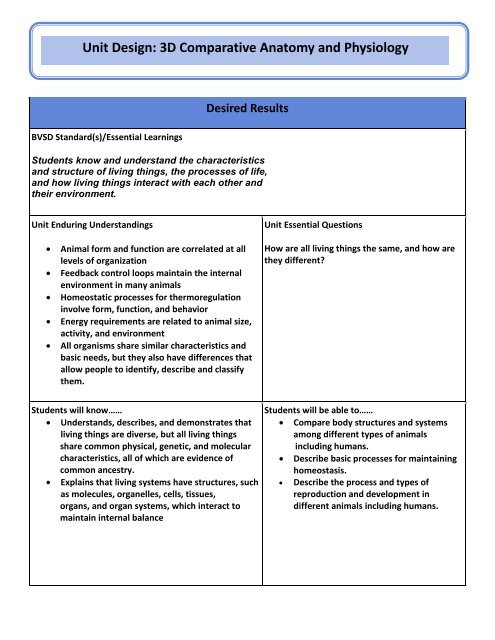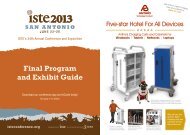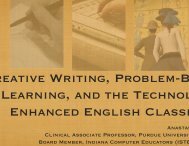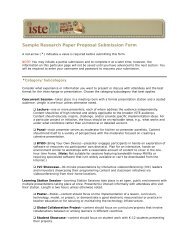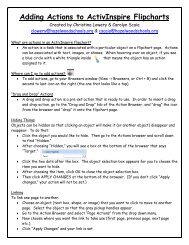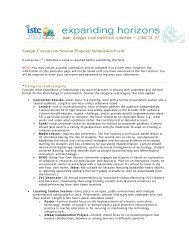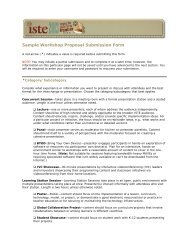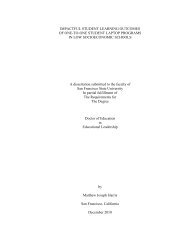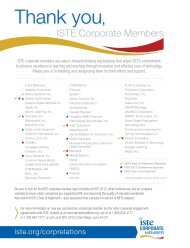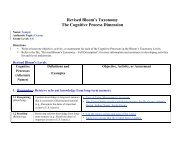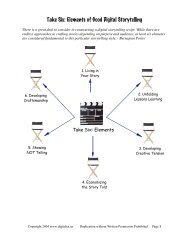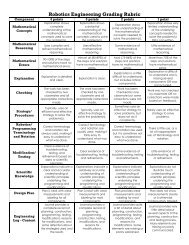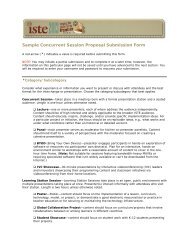Unit Design: 3D Comparative Anatomy and Physiology
Unit Design: 3D Comparative Anatomy and Physiology
Unit Design: 3D Comparative Anatomy and Physiology
You also want an ePaper? Increase the reach of your titles
YUMPU automatically turns print PDFs into web optimized ePapers that Google loves.
<strong>Unit</strong> <strong>Design</strong>: <strong>3D</strong> <strong>Comparative</strong> <strong>Anatomy</strong> <strong>and</strong> <strong>Physiology</strong><br />
Desired Results<br />
BVSD St<strong>and</strong>ard(s)/Essential Learnings<br />
Students know <strong>and</strong> underst<strong>and</strong> the characteristics<br />
<strong>and</strong> structure of living things, the processes of life,<br />
<strong>and</strong> how living things interact with each other <strong>and</strong><br />
their environment.<br />
<strong>Unit</strong> Enduring Underst<strong>and</strong>ings<br />
• Animal form <strong>and</strong> function are correlated at all<br />
levels of organization<br />
• Feedback control loops maintain the internal<br />
environment in many animals<br />
• Homeostatic processes for thermoregulation<br />
involve form, function, <strong>and</strong> behavior<br />
• Energy requirements are related to animal size,<br />
activity, <strong>and</strong> environment<br />
• All organisms share similar characteristics <strong>and</strong><br />
basic needs, but they also have differences that<br />
allow people to identify, describe <strong>and</strong> classify<br />
them.<br />
<strong>Unit</strong> Essential Questions<br />
How are all living things the same, <strong>and</strong> how are<br />
they different?<br />
Students will know……<br />
• Underst<strong>and</strong>s, describes, <strong>and</strong> demonstrates that<br />
living things are diverse, but all living things<br />
share common physical, genetic, <strong>and</strong> molecular<br />
characteristics, all of which are evidence of<br />
common ancestry.<br />
• Explains that living systems have structures, such<br />
as molecules, organelles, cells, tissues,<br />
organs, <strong>and</strong> organ systems, which interact to<br />
maintain internal balance<br />
Students will be able to……<br />
• Compare body structures <strong>and</strong> systems<br />
among different types of animals<br />
including humans.<br />
• Describe basic processes for maintaining<br />
homeostasis.<br />
• Describe the process <strong>and</strong> types of<br />
reproduction <strong>and</strong> development in<br />
different animals including humans.
Assessment Evidence<br />
Performance/Transfer Tasks<br />
• Students should be able to use what is seen on<br />
<strong>3D</strong> simulation <strong>and</strong> PowerPoint lecture to identify<br />
structures on a Fetal Pig <strong>and</strong> Earthworm<br />
• Students should be able to use what is seen on<br />
<strong>3D</strong> simulations to describe similarities <strong>and</strong><br />
differences between human, fetal pig, <strong>and</strong><br />
earthworm anatomy <strong>and</strong> physiology<br />
• Students should have a better underst<strong>and</strong>ing of<br />
the “enduring underst<strong>and</strong>ings” <strong>and</strong> should be<br />
able to demonstrate this underst<strong>and</strong>ing on an<br />
exam<br />
Rubric<br />
• See rubric for Optional Extenison: <strong>Comparative</strong><br />
<strong>Anatomy</strong> <strong>and</strong> <strong>Physiology</strong> Project<br />
Other Evidence<br />
• Completion of notes h<strong>and</strong>outs<br />
• Completion of Dissection Labs<br />
• Completion of <strong>Comparative</strong> <strong>Anatomy</strong> <strong>and</strong><br />
<strong>Physiology</strong> Project (Optional Extension)<br />
Student Self-Assessment <strong>and</strong> Reflection<br />
• Students will write answers to discussion<br />
questions on the notes h<strong>and</strong>outs <strong>and</strong> on<br />
the class discussion board
Learning Plans<br />
Learning Activities<br />
Time: 1 week broken down as follows-- 1 <strong>and</strong> 2 (55 min. class period); 3 (2-3 55 min. class periods); 4 (30<br />
minutes); 5 (20 min for a quiz; 50 min. for an exam); 6 (homework- 10-15 min. class discussion)<br />
1. PowerPoint on comparative anatomy <strong>and</strong> physiology with linked videos <strong>and</strong> Einstruction clicker<br />
questions to introduce material (have students take notes on a h<strong>and</strong>out from PowerPoint)<br />
2. Use <strong>3D</strong> Cyber<strong>Anatomy</strong> <strong>and</strong> other <strong>3D</strong> software to help students visualize differences <strong>and</strong><br />
similarities between various organisms, <strong>and</strong> help solidify vocabulary <strong>and</strong> identification of<br />
structures/functions. (have students take notes on h<strong>and</strong>out)<br />
3. On-line Virtual Pig <strong>and</strong> Earthworm dissection as a resource to actual h<strong>and</strong>s-on dissection labs for<br />
the Fetal Pig <strong>and</strong> the Earthworm. (Note: different organisms may be used, as long as at least one<br />
invertebrate <strong>and</strong> one vertebrate are used to show differences <strong>and</strong> similarities.)<br />
4. Use <strong>3D</strong> software <strong>and</strong> PowerPoints to review what was covered on dissection labs.<br />
5. Use <strong>3D</strong> software as a method to test students on their knowledge of the anatomy.<br />
6. Use Class discussion board to have students practice writing AP-like essays<br />
7. Optional Extension: Human <strong>Anatomy</strong> Project or <strong>Comparative</strong> Animals Project<br />
Materials<br />
<strong>3D</strong> computer, software <strong>and</strong> projector<br />
Student dissection lab h<strong>and</strong>outs<br />
Dissection supplies (including fetal pigs <strong>and</strong> earthworms…Can be purchased<br />
through Carolina Biological Supply)<br />
Student PowerPoint notes h<strong>and</strong>outs<br />
Optional Extension Project h<strong>and</strong>out <strong>and</strong> rubric<br />
Resources on:<br />
http://bvsd.org/schools/MonarchHigh/teachers/kdonley/Pages/default.aspx<br />
(click on following links: documents, documents, biology, finals reviews,<br />
finals PowerPoint)<br />
Accommodations<br />
Can vary the student<br />
notes h<strong>and</strong>outs so notes<br />
are easier to take for<br />
students…such as more<br />
“fill in the blank.”<br />
Technologies such as <strong>3D</strong>,<br />
video streaming,<br />
Einstruction clickers, <strong>and</strong><br />
h<strong>and</strong>s-on labs should<br />
accommodate for ALL<br />
learning styles
Technology Integration<br />
Use of Video streaming, Einstruction Clickers <strong>and</strong> <strong>3D</strong> software/hardware


